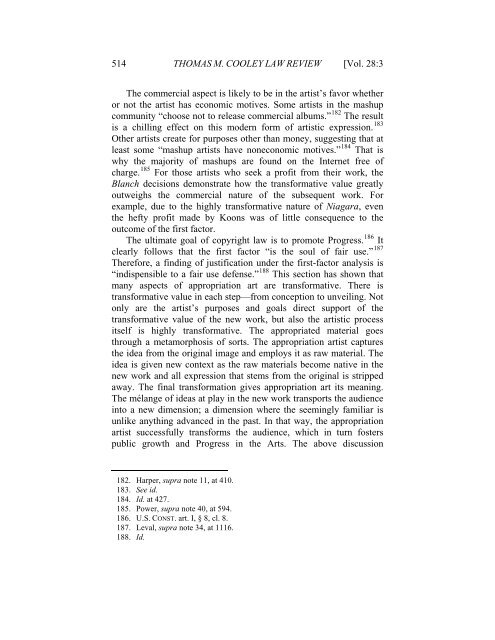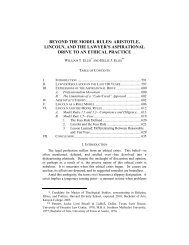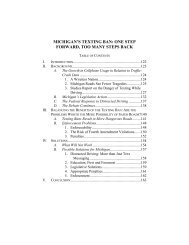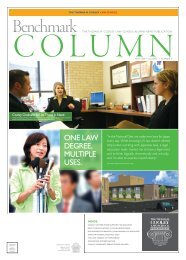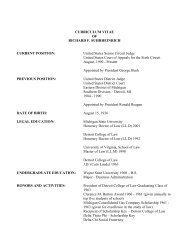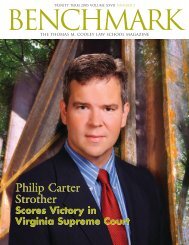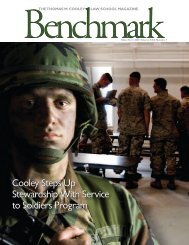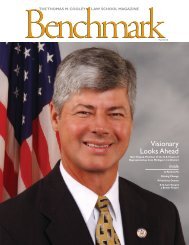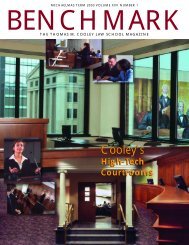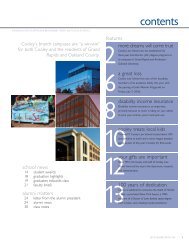Blanch It, Mix It, Mash It - Thomas M. Cooley Law School
Blanch It, Mix It, Mash It - Thomas M. Cooley Law School
Blanch It, Mix It, Mash It - Thomas M. Cooley Law School
Create successful ePaper yourself
Turn your PDF publications into a flip-book with our unique Google optimized e-Paper software.
514 THOMAS M. COOLEY LAW REVIEW [Vol. 28:3<br />
The commercial aspect is likely to be in the artist’s favor whether<br />
or not the artist has economic motives. Some artists in the mashup<br />
community “choose not to release commercial albums.” 182 The result<br />
is a chilling effect on this modern form of artistic expression. 183<br />
Other artists create for purposes other than money, suggesting that at<br />
least some “mashup artists have noneconomic motives.” 184 That is<br />
why the majority of mashups are found on the Internet free of<br />
charge. 185 For those artists who seek a profit from their work, the<br />
<strong>Blanch</strong> decisions demonstrate how the transformative value greatly<br />
outweighs the commercial nature of the subsequent work. For<br />
example, due to the highly transformative nature of Niagara, even<br />
the hefty profit made by Koons was of little consequence to the<br />
outcome of the first factor.<br />
The ultimate goal of copyright law is to promote Progress. 186 <strong>It</strong><br />
clearly follows that the first factor “is the soul of fair use.” 187<br />
Therefore, a finding of justification under the first-factor analysis is<br />
“indispensible to a fair use defense.” 188 This section has shown that<br />
many aspects of appropriation art are transformative. There is<br />
transformative value in each step—from conception to unveiling. Not<br />
only are the artist’s purposes and goals direct support of the<br />
transformative value of the new work, but also the artistic process<br />
itself is highly transformative. The appropriated material goes<br />
through a metamorphosis of sorts. The appropriation artist captures<br />
the idea from the original image and employs it as raw material. The<br />
idea is given new context as the raw materials become native in the<br />
new work and all expression that stems from the original is stripped<br />
away. The final transformation gives appropriation art its meaning.<br />
The mélange of ideas at play in the new work transports the audience<br />
into a new dimension; a dimension where the seemingly familiar is<br />
unlike anything advanced in the past. In that way, the appropriation<br />
artist successfully transforms the audience, which in turn fosters<br />
public growth and Progress in the Arts. The above discussion<br />
182. Harper, supra note 11, at 410.<br />
183. See id.<br />
184. Id. at 427.<br />
185. Power, supra note 40, at 594.<br />
186. U.S. CONST. art. I, § 8, cl. 8.<br />
187. Leval, supra note 34, at 1116.<br />
188. Id.


